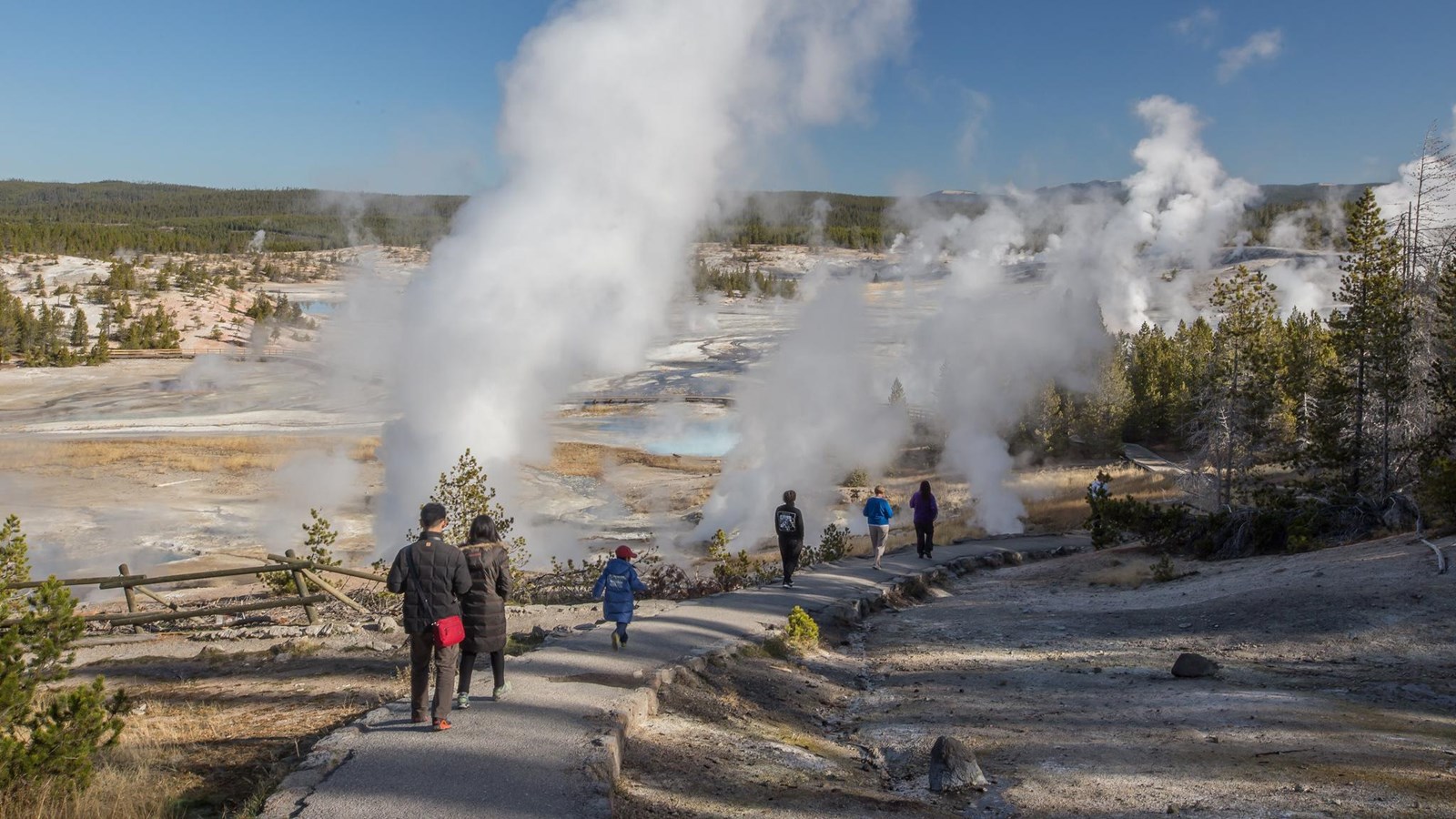Last updated: December 2, 2024
Place
Porcelain Basin Overlook

NPS / Matt Poyner
Historical/Interpretive Information/Exhibits
From this overlook, you can see milky blue pools saturated with silica, the primary component of glass. The thermal waters in Norris contain the highest concentration of silica in Yellowstone.
Some of the orange color results from minerals containing elements such as iron and arsenic. Thermophiles also create the colors you see, such as orange, greenish-black, and emerald green.
The boardwalk across Porcelain Basin takes you over hot, acidic waters. It also provides a place to observe thermophile communities such as the streamers and mats populated by Zygognium, an alga dark on the surface but bright green beneath. It thrives in water of pH 2-3 and temperatures of 68 to 96 degrees Fahrenheit.
Look for the movement of ephydrid flies and other insects feeding off thermophile communities.
Geysers
Geysers have constrictions in their plumbing systems that prevent water from moving freely to the surface where heat would escape. Water beneath the constrictions creates a buildup of steam. Eventually the steam pushes water past the constrictions and the geyser erupts.
Hot Springs
Hot springs are the most common hydrothermal features in Yellowstone. Their plumbing has no constrictions.
Superheated water cools as it reaches the surface, sinks, and is replaced by hotter water from below.
This circulation prevents water from reaching the temperature needed to set off an eruption.
Fumaroles
Fumaroles or steam vents, are the hottest hydrothermal features in the park. The limited amount of water flashes into steam before reaching the surface. The result is a loud hissing of steam and gases.
Color and Heat Lovers
Hydrothermal features are also habitats in which microscopic organisms survive and thrive. They are called thermophiles: "thermo" for heat and "phile" for lover.
Although they are too small to be seen with the naked eye, trillions are grouped together and appear as masses of color. They are nourished by energy and chemical building blocks.
Colorless and yellow thermophiles grow in the hottest water.
Orange, brown, and green thermophiles grow in cooler waters.
Imagine living in near-boiling temperatures, in hydrothermal features with the alkalinity of baking soda, or in water so acidic that it can burn holes in clothing. Microorganisms in Yellowstone need these extremes to survive.
Norris Geyser Basin
Norris Geyser Basin is one of the hottest and most acidic of Yellowstone’s hydrothermal areas. It is outside of the most recent Yellowstone caldera, but inside the first and largest caldera. It sits on the intersection of three major faults and is a very active earthquake area.
Each year, new hot springs and geysers appear while others become dormant. Geologic events trigger many of these changes. Even small earthquakes can alter hydrothermal behavior. This sudden activity is known as a “thermal disturbance” and can last a few days, or more than a week. Gradually, most features return to “normal.”
No one fully understands why this happens. Norris has the greatest water chemistry diversity among Yellowstone’s hydrothermal areas. The water chemistry changes as the water levels of underground hot water reservoirs fluctuates.
Although Norris is known for its acid features, it also have alkaline hot springs and geysers. As underground water and chemistry shift suddenly, they could contribute to dramatic changes in minerals and pH.
Use Caution in Hydrothermal Areas
- Stay on boardwalks and designated trails.
- Hydrothermal water can severely burn you.
- Never run, push, or shove.
- Supervise children at all times.
- Do not scratch hydrothermal mats.
You are responsible for your safety.
Think safety, act safely. Yellowstone is a dangerous place.
